
- Home
- Brand
- Ancheer (26)
- Aqua Marina (35)
- Bestway (27)
- Billabong (22)
- Body Glove (28)
- Catch Surf (21)
- Channel Islands (25)
- Elecwish (25)
- Fcs (27)
- Funwater (42)
- Goplus (34)
- Greg Noll (24)
- Hobie (25)
- Lost (36)
- Morey (27)
- Paragon Surfboards (28)
- San Diego Surf Art (32)
- Tesla (34)
- Valwix (41)
- Wavestorm (32)
- ... (3833)
- Gender
- Model
- Pattern Type
- Size
- Sport Type
RARE Duke Kahanamoku Collection Vintage Surfing Card Hawaii Freemason Olympian
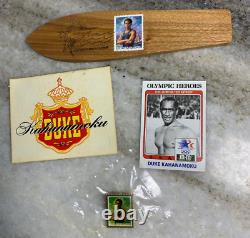
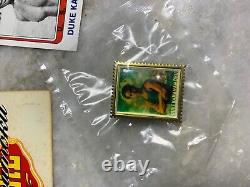
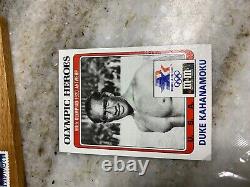
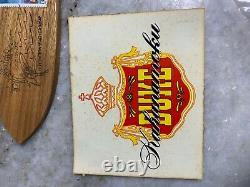
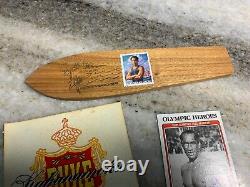
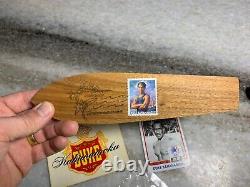
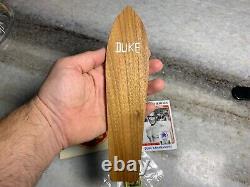
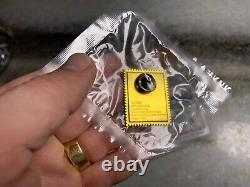
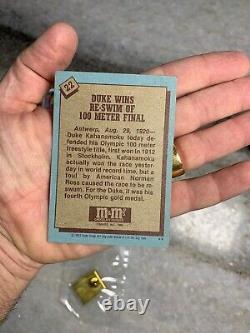
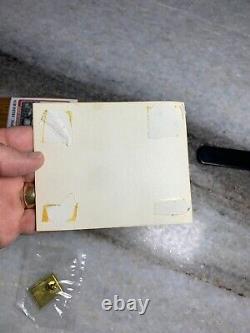


Duke Paoa Kahinu Mokoe Hulikohola Kahanamoku (August 24, 1890 - January 22, 1968) was a Hawaiian competition swimmer who popularized the sport of surfing. He was born to a minor noble family less than three years before the overthrow of the Hawaiian Kingdom.
He lived to see the territory's admission as a state. And became a United States citizen.
He was a five-time Olympic medalist in swimming. Kahanamoku joined fraternal organizations: he was a Scottish Rite Freemason. He worked as a law enforcement.Officer, an actor, a beach volleyball player, and a businessman. According to Kahanamoku, he was born in Honolulu. The home of Bernice Pauahi Bishop. Which was later converted into the Arlington Hotel. He was born into a family of Native Hawaiians.
Headed by Duke Halapu Kahanamoku and Julia Pa? He had five brothers, and three sisters. David, William and Louis, all of whom participated in competitive aquatic sports. His sisters were Bernice, Kapiolani and Maria.
"Duke" was not a title or a nickname, but a given name. He was named after his father, Duke Halapu Kahanamoku, who was christened by Bernice Pauahi Bishop in honor of Prince Alfred, Duke of Edinburgh.
His father was a policeman. Akonia Lonokahikina Paoa was a deeply religious woman with a strong sense of family ancestry. His parents were from prominent Hawaiian ohana. The Kahanamoku and the Paoa ohana were considered to be lower-ranking nobles, who were in service to the ali? His paternal grandfather was Kahanamoku and his grandmother, Kapiolani Kaoeha (sometimes spelled Kahoea), a descendant of Alapainui.
They were kahu, retainers and trusted advisors of the Kamehamehas, to whom they were related. His maternal grandparents Paoa, son of Paoa Hoolae and Hiikaalani, and Mele Uliama, were also of ali?In 1893, his family moved to Kalia. Waikiki near the present site of Hilton Hawaiian Village. , to be closer to his mother's parents and family. Kahanamoku grew up with his siblings and 31 Paoa cousins. He attended the Waikiki Grammar School, Kaahumanu School, and the Kamehameha Schools.
Although he never graduated because he had to quit to help support the family. Growing up on the outskirts of Waikiki, Kahanamoku spent much of his youth at the beach, where he developed his surfing and swimming skills. In his youth, Kahanamoku preferred a traditional surf board, which he called his "papa nui", constructed after the fashion of ancient Hawaiian olo boards.
Made from the wood of a koa. Tree, it was 16 feet (4.9 m) long and weighed 114 pounds (52 kg). The board was without a skeg. Which had yet to be invented. In his later surfing career, he would often use smaller boards but always preferred those made of wood.Kahanamoku was also a powerful swimmer. On August 11, 1911, Kahanamoku was timed at 55.4 seconds in the 100 yards (91 m) freestyle.
Beating the existing world record by 4.6 seconds, in the salt water of Honolulu Harbor. He also broke the record in the 220 yd (200 m) and equaled it in the 50 yd (46 m). But the Amateur Athletic Union. (AAU), in disbelief, would not recognize these feats until many years later. The AAU initially claimed that the judges must have been using alarm clocks rather than stopwatches and later claimed that ocean currents aided Kahanamoku.Duke Kahanamoku with his solid redwood surfboard, in Corona Del Mar, California. Kahanamoku easily qualified for the U.
Olympic swimming team in 1912. At the 1912 Summer Olympics. In Stockholm, he won a gold medal in the 100-meter freestyle.
And a silver medal with the second-place U. Team in the men's 4×200-meter freestyle relay. In Antwerp, Kahanamoku won gold medals in both the 100 meters bettering fellow Hawaiian Pua Kealoha. He finished the 100 meters with a silver medal during the 1924 Olympics. In Paris, with the gold going to Johnny Weissmuller. And the bronze to Kahanamoku's brother, Samuel. By then age 34, Kahanamoku won no more Olympic medals. But he served as an alternate for the U. Team at the 1932 Summer Olympics. Between Olympic competitions, and after retiring from the Olympics, Kahanamoku traveled internationally to give swimming exhibitions. He attracted people to surfing in mainland America first in 1912 while in Southern California. His surfing exhibition at Sydney, Australia. On December 24, 1914, is widely regarded as a seminal event in the development of surfing in Australia. The board that Kahanamoku built from a piece of pine from a local hardware store is retained by the Freshwater Surf Life Saving Club. A statue of Kahanamoku was erected in his honor on the Northern headland of Freshwater Lake, New South Wales. During his time living in Southern California, Kahanamoku performed in Hollywood as a background actor and a character actor in several films. He made connections in this way with people who could further publicize the sport of surfing. Kahanamoku was involved with the Los Angeles Athletic Club.Acting as a lifeguard and competing in both swimming and water polo teams. While living in Newport Beach, California. On June 14, 1925, Kahanamoku rescued eight men from a fishing vessel that capsized in heavy surf while it was attempting to enter the city's harbor.
Two other surfers saved four more fishermen, while five succumbed to the seas before they could be rescued. At the time the Newport Beach police chief called Kahanamoku's efforts The most superhuman surfboard rescue act the world has ever seen. It also led to lifeguards across the US to begin using surfboards as standard equipment for water rescues.
He was the first person to be inducted into both the Swimming Hall of Fame. And the Surfing Hall of Fame. The Duke Kahanamoku Invitational Surfing Championships. He is a member of the U. From 1932 to 1961, completing 13 consecutive terms. During World War II, he also served as a military police. Officer for the United States; Hawai'i was not yet a state and was administered.In the postwar period, he also appeared in a number of television programs and films, such as Mister Roberts. He was well-liked throughout the Hollywood community. Kahanamoku became a friend and surfing companion of heiress Doris Duke.
She built a home (now a museum) on Oahu. Kahanamoku gave private surfing lessons to Franklin D.
The children of Franklin D. In 1946, Kahanamoku was the pro forma. Defendant in the landmark Supreme Court. While Kahanamoku was a military police. Officer during World War II.He arrested Duncan, a civilian shipfitter. This effectively instituted martial law. After Duncan was tried by a military tribunal, he appealed to the Supreme Court. In a post hoc ruling, the court ruled that trial by military tribunal for the civilian was, in this case, unconstitutional. Ohio, after she had been hired to teach at the Royal Hawaiian Hotel.
Duke was 50 years old, Nadine was 35. He was initiated, passed and raised to the degree of Master Mason in Hawaiian Lodge Masonic Lodge. And was also a Noble (member) of the Shriners.
Kahanamoku died of a heart attack on January 22, 1968, at age 77. For his burial at sea. A long motorcade of mourners, accompanied by a 30-man police escort, traveled in procession across town to Waikiki Beach. The pastor of Kawaiahao Church.
A group of beach boys sang Hawaiian songs, including Aloha Oe. , and Kahanamoku's ashes were scattered into the ocean. In 1994 a statue of Kahanamoku by Barry Donohoo was inaugurated in Freshwater, NSW, Australia. It is the showpiece of the Australian Surfers Walk of Fame. On February 28, 2015, a monument featuring a replica of Kahanamoku's surfboard was unveiled at New Brighton beach, Christchurch.
In honor of the 100th anniversary of Kahanamoku's visit to New Brighton. A statue of Kahanamoku was installed in Huntington Beach, California. A nearby restaurant is named for him and is close to Huntington Beach pier. The City of Huntington Beach identifies with the legacy of surfing, and a museum dedicated to that sport is located here. In April 2022 NSW Heritage announced that Kahanamoku would be included in the first batch of Blue Plaques to be issued, to recognize his contribution to recreation and surfing.
A sculpture of Kahanamoku flanked by a male knee paddler and a female prone paddler commemorating the Catalina Classic Paddleboard Race was installed on the Manhattan Beach Pier. Capitalized on Kahanamoku's popularity by naming his Waikiki showroom "Duke Kahanamoku's" at the International Market Place. It was a major Waikiki showroom in the 1960s and is remembered as the home of Don Ho.
& The Aliis from 1964 through 1969. The Duke Kahanamoku Aquatic Complex (DKAC) serves as the home for the University of Hawai'i's swimming and diving and women's water polo teams. The facility, located on the University's lower campus, includes a 50-meter training pool and a separate 25-yard competition and diving pool. The long course pool is four feet at both ends, seven feet in the middle, and an average depth of six feet. Kahanamoku's name is also used by Duke's Canoe Club & Barefoot Bar, as of 2016 known as Duke's Waikiki, a beachfront bar and restaurant in the Outrigger. Waikiki on the Beach Hotel. On August 24, 2002, the 112th anniversary of Kahanamoku's birth, the U. Issued a first-class commemorative stamp. With Duke's picture on it. The First Day Ceremony was held at the Hilton Hawaiian Village in Waikiki and was attended by thousands.At this ceremony, attendees could attach the Duke stamp to an envelope and get it canceled with a First Day of Issue postmark. On August 24, 2015, a Google Doodle. Honored the 125th anniversary of Duke Kahanamoku's birthday. No Father to Guide Him.
Around the World with Douglas Fairbanks. Bit part as surf instructor. Wake of the Red Witch.
